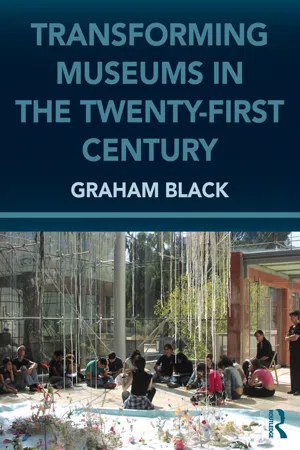
- 276 pages
- English
- ePUB (mobile friendly)
- Available on iOS & Android
Transforming Museums in the Twenty-first Century
About this book
In his book, Graham Black argues that museums must transform themselves if they are to remain relevant to 21st century audiences – and this root and branch change would be necessary whether or not museums faced a funding crisis. It is the result of the impact of new technologies and the rapid societal developments that we are all a part of, and applies not just to museums but to all arts bodies and to other agents of mass communication.
Through comment, practical examples and truly inspirational case studies, this book allows the reader to build a picture of the transformed 21st century museum in practice. Such a museum is focused on developing its audiences as regular users. It is committed to participation and collaboration. It brings together on-site, online and mobile provision and, through social media, builds meaningful relationships with its users. It is not restricted by its walls or opening hours, but reaches outwards in partnership with its communities and with other agencies, including schools. It is a haven for families learning together. And at its heart lies prolonged user engagement with collections, and the conversations and dialogues that these inspire.
The book is filled to the brim with practical examples. It features:
- an introduction that focuses on the challenges that face museums in the 21st century
- an analysis of population trends and their likely impact on museums
- boxes showing ideas, models and planning suggestions to guide development
- examples and case studies illustrating practice in both large and small museums
- an up-to-date bibliography of landmark research, including numerous websites
Sitting alongside Graham Black's previous book, The Engaging Museum, we now have a clear vision of a museum of the future that engages, stimulates and inspires the publics it serves, and plays an active role in promoting tolerance and understanding within and between communities.
Frequently asked questions
- Essential is ideal for learners and professionals who enjoy exploring a wide range of subjects. Access the Essential Library with 800,000+ trusted titles and best-sellers across business, personal growth, and the humanities. Includes unlimited reading time and Standard Read Aloud voice.
- Complete: Perfect for advanced learners and researchers needing full, unrestricted access. Unlock 1.4M+ books across hundreds of subjects, including academic and specialized titles. The Complete Plan also includes advanced features like Premium Read Aloud and Research Assistant.
Please note we cannot support devices running on iOS 13 and Android 7 or earlier. Learn more about using the app.
Information
Section 1 From Visitor to User
Getting to Know Our Users Better
All our traditional arts organisations were developed in very different times, for audiences very different from those we address now. If we are to adapt at the speed set by the fast-changing world around us, then audience insight is the catalyst we need to help us match that pace of change.Morris and McIntyre (undated: 2)
Introduction: From Visitor to User
- Intelligence: an awareness of the changing world around us that looks way beyond our own database, and
- Insight: an understanding of the needs, attitudes and motivations of our existing and potential audiences.
Morris and McIntyre (undated: 2)
- the ‘traditional’ on-site visitor to a Western museum is white, professional class and well educated
- for most of our users, a visit to a museum represents an occasional leisure-led event
- the family group is frequently the largest audience, characteristically making up from 40 per cent to 55 per cent of total visitor numbers
- slightly more adult females than males visit, except to military and industrial museums
- ethnic and racial minority groups, young people and families with children under 5 years old are under-represented among museum visitors, and
- there are clear peaks and troughs in visitation through the week and year, with different segments also coming at different times.
Audience Segmentation
- Demographics:
- age
- gender
- educational level attained
- Family status is heavily used in segmentation, as it can be such a major predictor of behaviour (dependant; pre-family; family at different stages; late life-cycle, including empty nesters). In the past, ethnic or racial origin has been a rare factor in visitor surveys, but this has changed as museums seek to respond to the needs of changing local communities and broaden their audience base. There is substantial evidence that the higher the educational level attained, the more often people will visit museums.
- Geography:
- resident/local
- day tripper
- tourist: – VFR (visitor staying with friends or relatives)
- national
- international
- Class/occupation:There is ongoing controversy over the concept of social class and its relationship to income, education and occupation but here is not the place to discuss it. Social class and occupation, however, continue to be used as key market segments. Although the British government introduced a new National Statistics Socio-Economic Classification in 2000, the Social Class based on Occupation classification is still the most ...
Table of contents
- Cover Page
- Half Title Page
- Title Page
- Copyright Page
- Dedication
- Contents
- List of figures
- Acknowledgements
- Introduction: Change or Die
- Section 1 From Visitor to User
- 1 Getting to Know Our Users Better
- 2 Stimulating Visits, Building Relationships
- 3 Welcoming and Supporting the Museum User
- Section 2 The Twenty-First Century Museum
- 4 Informal Learning
- 5 Museums and Formal Learning
- 6 Conversations Around Collections
- 7 Stimulating Family Conversations in the Museum
- 8 From engaging Communities to Civil Engagement
- 9 Endpiece: The Future of the Museum Exhibition
- Bibliography
- Index